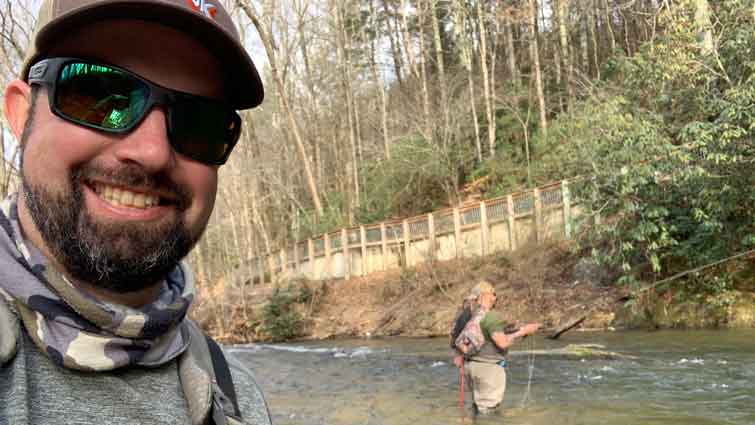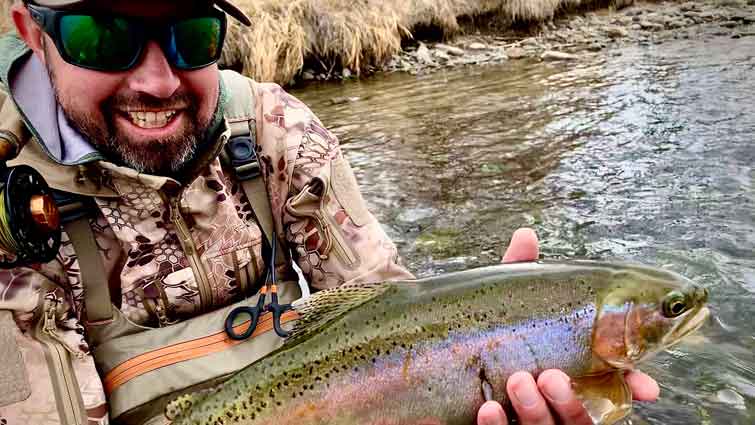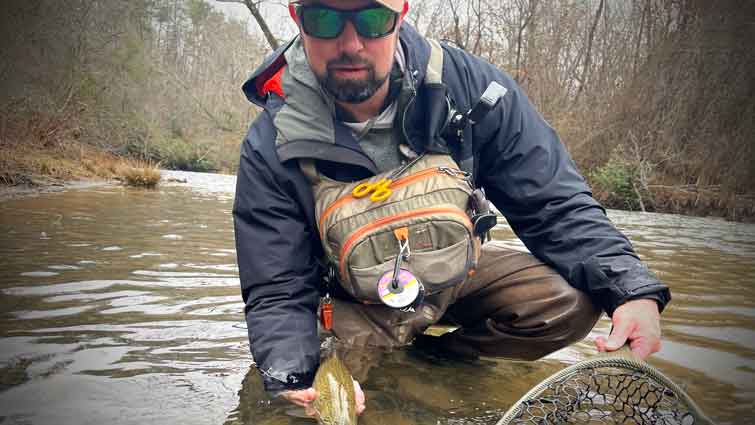If you are looking for some great sunglasses to try while fishing for trout, then there are a few things to consider. Before purchasing new fly fishing gear, consider the environment that you will be fishing in. Where are you fishing? How bright is it where you are going? Do you want polarized lenses or not?
The best type of sunglasses for trout fishing are polarized sunglasses. If you are fishing on really bright days, then you should consider some amber-tinted lenses to help cut through the brightness. The goal is to be able to see into the through the water to the trout that you are fishing for.

If you are fishing in a normal environment with average light conditions, then most lenses will work for this type of fishing. You might consider polarized lenses if you like cutting through glare or sunlight to see your lure or line better. Read on to discover some of the most popular lenses for trout fishing.
What Type of Sunglasses Are Best to Use When Trout Fishing?
We've touched on the benefits of polarized sunglasses when trout fishing, but there are multiple other options that you can use that have equal benefits or work better in different conditions.
On bright sunny days, blue or green mirror lenses cut through the water better and make it easier to see clear colors. If you are fishing at dawn or dusk or on a cloudy day, switch to silver mirrors, as they will allow you to see your line with ease over a green lens.
Protection from bright sunlight and glare while sunglasses for trout fishing cannot be underestimated. Even on an average sunny day, bright sun can harm your retinas and cause irreparable damage that will keep you from enjoying the outdoors as much as normal. Any of these options will protect your eyes while letting you enjoy all of nature's splendor on any given day.

UV protection is another feature that every good pair of sunglasses should have when trout fishing or doing anything else outside where there is a chance for exposure to ultraviolet light coming from the sun. If your eyes are not protected, UV beams can cause damage to your retinas that is potentially dangerous. Fortunately, every one of these options blocks ultraviolet rays for optimal eye protection.
Choosing a lens color brings up two main questions:
- Will you be fishing in clear waters, and if not;
- What conditions will you be facing?
Let's look at some of the best color options for sunglass lenses and what conditions they're best for.

Blue Lenses
Blue lenses are best in full sun situations and flat, open water conditions. Blue lenses are used to cut down on the amount of light that enters your eyes, giving you a better view of darker conditions. Whether you're fishing in the late morning or early afternoon, blue lenses will provide you with a clear and sharp look at what's around you.

Green/ Green Mirror Lenses
Green lenses are best in full-sun/partially cloudy conditions and on waters with a lot of movement where darker colors help conceal fish well. Green lenses create contrast when fishing inshore.

Gray / Neutral Gray Lenses
Gray lenses are great for all types of fishing, but like blue or green lenses, they're not recommended for low light conditions. They do, however, work well in sunny to partly cloudy conditions and even at night when artificial light sources are present, such as during ice fishing sessions.

Silver Mirror Lenses
Silver mirror lenses provide color contrast in full sunlight. This color lens is well suited for stream fishing and environments with varying light. They are great for freshwater fishing where vegetation is sparse, but be aware that these lenses can cast a greenish hue over anything underwater, so they're not our top pick for trout fishing.

Copper Lenses
Copper lenses are some of the best for trout fishing. These lenses are similar to silver mirror lenses, but they cast a slightly brighter image. They provide excellent contrast in sunny conditions, which make fishing the brightest of days easy. Fish can be easily located with these lenses even when you're casting over deeper water. These lenses can be used in lower light since they're excellent at cutting glare.

Amber/Brown Lenses
Brown lenses offer the maximum amount of protection against harsh sunlight and sodium vapor lights from street lamps. They also provide optimal clarity for spotting fish in darker waters where more light is needed. If there is any chance for extremely bright conditions where shadows could be an issue, brown lens sunglasses are best to use so as not to impair your vision with other lenses colors.

Yellow Lenses
Yellow lenses are optimal at sunrise and sunset when the water has a greenish tint from shallow water and underwater plants. The yellow lenses maximize this range so your eyes can see the natural colors of the fish most accurately. These lenses allow for optimal vision when sight fishing in clear or murky waters and in water that is deeper than ten feet.

Do You Need Polarized Sunglasses for Fly Fishing?
Polarized lenses are best for assistance in spotting the fish below the surface of the water. The polarization blocks the glare from above and helps you to see into the depths of the water. They also allow for optimal vision when sight fishing in clear or murky waters and in water that is deeper than ten feet.
You should definitely invest in polarized lenses for fly fishing. Polarized glasses help you see clearer. Reduced glare on the water's surface will allow you to easily pick fish in any environment.
When choosing which polarized sunglasses to invest in, consider the conditions you typically fish in. For example, if you are fishing in hazy, overcast conditions, then a lighter lens color would be best. If it happens to be sunny, choose darker lenses to reduce the intensity of the sun's glare.
Consider investing in mirrored lenses if you are fishing on flat water or in clear conditions. These lenses are great for low light conditions, and they will help reflect the sun away from your eyes. The mirrored coating also helps prevent haze and atmospheric disturbances that may affect your vision.

Polycarbonate vs. Glass Lenses
Polycarbonate lenses are great for most conditions. They are lightweight and shatterproof, which is important since they may be exposed to rocks or other debris in the river. These lenses typically come with scratch-resistant coatings. If you fish in muddy water or spend a lot of time dealing with spray from big fish, then polycarbonates will be your best option.
Glass lenses are slightly heavier than polycarbonate lenses. They are not as impact-resistant, and they may shatter if broken, so you will want to be more careful with them. On the bright side, glass lenses typically have better scratch-resistance than their polycarbonate counterparts.
The only advantage that polycarbonate lenses have over glass lenses is that they are much more impact-resistant, which is great if you fish in an area where there are lots of rocks or other debris in the water. However, this may make them slightly less scratch-resistant than glasses made from glass. Polycarbonates typically come with a scratch-resistant coating to help extend their life.

Are All Polarized Lenses the Same?
Polarized sunglasses are made by placing a filter in front of the lens. This filter blocks horizontal light waves that are reflected off water surfaces or other non-metallic surfaces. These reflected waves would normally enter your eyes, but the polarized lenses reduce these waves, keeping them from reaching your eyes.
There are different levels of polarization. While all polarizing lenses cut out reflected glare, choosing highly polarized lenses is important for the best vision and comfort on the water.
Lightly polarized sunglasses will ultimately let more reflected light in than the lenses, so choose these carefully since some are better at cutting through surface glare than eliminating it. Strongly polarized lenses will offer the best vision and comfort when fishing on bright days or on the water with high levels of surface glare.
It's important to consider what you are typically fishing in. If it happens to be hazy or overcast conditions, then you would probably want lighter lenses. However, if it is sunny out, then choose darker lenses. The polarized coating will help cut down on the intensity of the sun's glare and also block any atmospheric disturbances that may affect your vision.

Polarized Lenses vs. Mirrored Lenses
Mirrored lenses do offer more protection from the sun's harmful UV rays, but polarized lenses will give you a better look into the water to spot fish.
Many anglers like the mirrored lenses because they cut down on light coming in from above - which can be helpful if you are fishing overhanging trees with bright leaves or at times when the sun is particularly bright. But, most overlook that this will make seeing through murky green waters very difficult, if not impossible.
Polarized lenses cut through murkiness and surface glare and still allow for your eyes to see what is beneath and around them. They also provide far better contrast on the water, which makes it easier to see the fish and, more importantly, hook them.

Are Green Lenses Good for Fishing?
Green lenses are good for fishing in especially sunny conditions because they balance between yellow and gray. The green tint will allow you to see down into the water without creating an intense image like yellow lenses. Green lenses should only be used when it is sunny out.
Green lenses are good for inshore sight fishing. A green mirror applied to a high-contrast lens improves your vision even more. It bleaches out brown, muddy water while enhancing the greens to make it simpler to see fish.
Green lenses are perfect for sight fishing on a bright, clear day. They produce the best vision in sunny conditions by balancing out yellow and gray. When you're fishing in murky water from a boat, green lenses will help you to see fish lurking below the surface without making the water appear too yellow or too gray.

Are Blue Lenses Good for Fishing?
Blue lenses can be useful for fishing when the sun is shining, but they are best suited to deep-water fish. Like green lenses, blue lenses are good for improving vision in murky water. You can see fish swimming below the surface more clearly without making the water appear too yellow or gray.
Blue lenses are good for full-sun, offshore fishing. They provide the contrast needed to pick out bait fish at depth when waves are breaking on the surface. Blue lenses also make it easier to spot game fish cruising in open water.
If you're in a boat, this polarized shade will help you spot fish that swim beneath the surface because they prevent insects and other debris from scattering light in multiple directions. They also make it easier to distinguish movement in the water since they reduce color distortion caused by refraction at different depths.

Which Is Better; 580P or 580G?
The top-of-the-line sunglasses from Costa are the 580P. The “P” on these 580P shades stands for Polycarbonate, which indicates that the lenses are composed of Polycarbonate material. Six-layer materials are used to make the lens of these 580P polarized glasses.
580G sunglasses are going to be better in most situations. The major distinction is the lens construction material. The lenses of the 580G are constructed with superior glass sheets, as opposed to polycarbonate/plastic on the 580P models.
Both have advantages and disadvantages. However, because of its toughened construction, the glass is more scratch-resistant, and it should resist even a significant impact.
Some of the best polarized sunglasses for trout fishing are those with copper and amber polarized lenses. Copper is great for fishing under overcast skies or in low light conditions. Amber lenses are great for bright days with glare on the water.
Consider the material lenses are made from. Polycarbonate lenses provide good protection for standard use. Glass lenses are more hard-wearing and more scratch-resistant but can also shatter or break if they get hit with something sharp like a rock. Consider the features of your sunglasses carefully before making a purchase.




